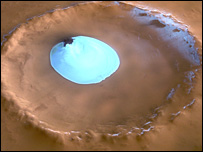The abundance of bright peaks could be due to this ice being recently exposed

Images transmitted by the European Mars Express spacecraft have apparently revealed for the first time an active glacier on the Red Planet. It should be noted that glacial formations were discovered earlier on the Olympus Mons volcano, but it is believed that these formations are four million years old. In contrast, this glacier may be relatively young, only a few thousand years old. Now European scientists are proposing to make the glacier a landing destination for one of the next Mars spacecraft, to search there not only for water but also for signs of life.
The young glacier appeared in the Deuteronilus Mensae region that lies between the towering mountains in the south and the flat plain in the northern hemisphere of Mars. "If this was a picture of the Earth I would straight up say it's a glacier," Dr. Gerald Neukom of the Free University of Berlin, who is the lead scientist in charge of the High Resolution Stereoscopic Imaging Camera (HRSC), told the BBC website.
"We were unable to detect the signs of the spectral signature of the water, but we intend to continue to study the glacier when the spacecraft passes over it again in the coming months and make additional measurements. White peaks can clearly be seen on the ridges of the glacier, indicating recently exposed ice. Such a discovery is rare and so far only such sites have been discovered because as soon as the ice is exposed to the evaporating environment, it takes off (turns from a solid state directly into a gas)."
According to Newcom, it is estimated that the glacier rose from the ground during the last tens of thousands of years when water burst out and froze. "This means that this is an active glacier now. This is a unique phenomenon," says Newcom.
Not all researchers share this opinion regarding the event. There are those who believe that the snows that occasionally fall on Mars are the causes of the development of glaciers, like on Earth. But according to Newcom, the paucity of precipitation on the Red Planet reduces the chances of this.
According to him, this glacier might be a good area to send a robotic spacecraft to look for evidence of life on Mars. "If bacteria survived deep in the soil beneath Mars, they could reach the surface using water that erupted from the depths."
Last month, the European Space Agency celebrated five thousand laps of the spacecraft, which was launched to Mars on December 25, 2003.

7 תגובות
There can't be life outside the earth.. there is no other place in the universe like DHA. Every planet contains a different component except for earth which is the only one where it is possible to exist because it contains everything necessary for life... stop going crazy!!!
Your whole approach is fundamentally wrong
If there is life, it is not necessary to expect it to behave on our level, meaning:
from the same sources as water, food, minerals, oxygen, light, etc.
And it is not necessary that everything is focused on our senses
It is very possible that they operate in different light intensities (not visible light), infrasound, etc.
All attempts to look for sources similar to ours and project them onto other stars are fundamentally wrong, since the conditions are completely different and do not meet the basic criteria of "life".
It's a shame that the photo in the news doesn't show the glacier in question.
The correct photo appears in the news on the following website:
http://news.bbc.co.uk/1/hi/sci/tech/7151190.stm
Is the diameter of the crater you see in the picture known?
It is very good not to ignore such vital details in the news
that are published.
It is not clear why to look for life in a young glacier instead of an ancient one. After all, logic says that the chances of finding life tend to favor the case where they had enough time to develop, right?
Wow, it's amazing, it will be possible to ski there!! :-))
And the truth? It is very strange that they have been photographing Mars from all directions and from all possible angles for years, and only now have they discovered this glacier which is so prominent with its white color on the surface, how is it possible that they missed something so prominent?
Anyway, it's just amazing! And maybe they will find life there? 🙂
exciting.
I hope that it will not turn out to be just a white mineral deposit and that the spectral signature that will focus on the suspicious area will show beyond any doubt that it is water.
I personally believe that life can be found almost anywhere. Even in places where they haven't been found yet like the moon. But if it is a large block of ice on the reddish ground, then there they will probably find special life: life that resembles the form of life on Earth.